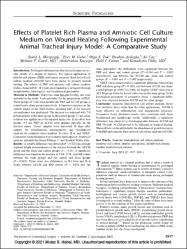| dc.contributor.author | Mirapoğlu, Semih | |
| dc.contributor.author | Güler, Eray Metin | |
| dc.contributor.author | Tok, Olgu Enis | |
| dc.contributor.author | Aydoğdu, İbrahim | |
| dc.contributor.author | Çay, Ali | |
| dc.contributor.author | Çamlı, Mehmet | |
| dc.contributor.author | Koçyiğit, Abdurrahim | |
| dc.contributor.author | Canter, Halil İbrahim | |
| dc.contributor.author | Yıldız, Kemalettin | |
| dc.date.accessioned | 2021-08-03T09:01:54Z | |
| dc.date.available | 2021-08-03T09:01:54Z | |
| dc.date.issued | 2021 | en_US |
| dc.identifier.citation | Mirapoğlu, S., Güler, E. M., Tok, O. E., Aydoğdu, İ., Çay, A., Çamlı, M. ... Yıldız, K. (2021). Effects of platelet rich plasma and amniotic cell culture medium on wound healing following experimental animal tracheal injury model: A comparative study. Journal of Craniofacial Surgery, 32(5), 1937-1941. https://dx.doi.org/10.1097/SCS.0000000000007396 | en_US |
| dc.identifier.issn | 1049-2275 | |
| dc.identifier.issn | 1536-3732 | |
| dc.identifier.uri | https://dx.doi.org/10.1097/SCS.0000000000007396 | |
| dc.identifier.uri | https://hdl.handle.net/20.500.12511/7657 | |
| dc.description.abstract | Introduction: Prolonged inflammation after tracheal injury invariably results in a degree of stenosis. The topical application of platelet-rich plasma (PRP) and human amniotic fluid-derived cell culture medium (ACCM) have been shown to promote wound healing. The effects of PRP and amniotic cell culture medium (Gibco AmnioMAX - II ) were investigated in a rat model through morphometric, histological, and biochemical parameters. Material & Methods: Thirty-two male Sprague Dawley rats were included in the study: 4 rats provided for the preparation of PRP. Three groups of 7 rats were divided into PRP and ACCM groups, a control and a sham group respectively. A transverse incision on the ventral aspect of the third trachea spanning half of the tracheal circumference was performed. The incision was repaired with 7/0 polypropylene in the sham group. In the control group, 0.5 ml saline solution was applied on to the repaired injury site. In the other two groups, 0.5 mL PRP or ACCM were applied topically on the tracheal repair. Tissue samples were harvested 30 days after surgery for morphometric measurements and biochemical analyses for oxidative stress markers, IL-1beta, IL-6, and VEGF. Connective tissue thickness was evaluated histologically. Statistical analysis included the Mann-Whitney U and Kruskal Wallis tests. Results: A notable difference was detected (P = 0,025) in cartilage segment length measurements of the trachea between the ACCM group and the sham and control groups (P < 0.03). A significant difference was found in the analysis of TAS, TOS, and OSI values between the study groups and the control and sham groups (P < 0.005). There were also differences in IL1-beta and IL-6 levels between ACCM and PRP groups (P < 0.05). For the same parameters, the differences were significant between the PRP and, sham and control groups (P = 0,004 and P = 0,002 respectively), and between the ACCM and, sham and control groups (P = 0,003 and P = 0,002 respectively). VEGF values demonstrated a significant difference between the PRP and sham group (P = 0,002), and between ACCM and sham/control groups (p=0,002 for both), the highest VEGF value was in ACCM group while the lowest value was in the sham group. In the histological assessment of connective tissue, a significant difference was observed between ACCM and the other groups. Conclusion: Amniotic fluid-derived cell culture medium shows less oxidative stress status than the other applications. ACCM is more effective on inflammatory and angiogenetic processes. Connective tissue thickness results were consistent with those biochemical and morphologic results. Additionally, a significant difference was observed in histological data between ACCM and PRP. Overall, ACCM proved to be efficient on tracheal healing. These effects can be attributed to the abundance of growth factors in both PRP and amniotic fluid-derived cell culture medium (ACCM). | en_US |
| dc.language.iso | eng | en_US |
| dc.publisher | Lippincott Williams & Wilkins | en_US |
| dc.rights | info:eu-repo/semantics/embargoedAccess | en_US |
| dc.subject | Amniotic Fluid-Derived Cell Culture Medium | en_US |
| dc.subject | Amniotic Cell Culture | en_US |
| dc.subject | Platelet Rich Plasma | en_US |
| dc.subject | Platelet-Rich Plasma | en_US |
| dc.subject | Tracheal Injurytracheal Stenosis | en_US |
| dc.title | Effects of platelet rich plasma and amniotic cell culture medium on wound healing following experimental animal tracheal injury model: A comparative study | en_US |
| dc.type | article | en_US |
| dc.relation.ispartof | Journal of Craniofacial Surgery | en_US |
| dc.department | İstanbul Medipol Üniversitesi, Tıp Fakültesi, Temel Tıp Bilimleri Bölümü, Histoloji ve Embriyoloji Ana Bilim Dalı | en_US |
| dc.authorid | 0000-0002-4899-9146 | en_US |
| dc.identifier.volume | 32 | en_US |
| dc.identifier.issue | 5 | en_US |
| dc.identifier.startpage | 1937 | en_US |
| dc.identifier.endpage | 1941 | en_US |
| dc.relation.publicationcategory | Makale - Uluslararası Hakemli Dergi - Kurum Öğretim Elemanı | en_US |
| dc.identifier.doi | 10.1097/SCS.0000000000007396 | en_US |
| dc.identifier.wosquality | Q4 | en_US |
| dc.identifier.scopusquality | Q2 | en_US |


















